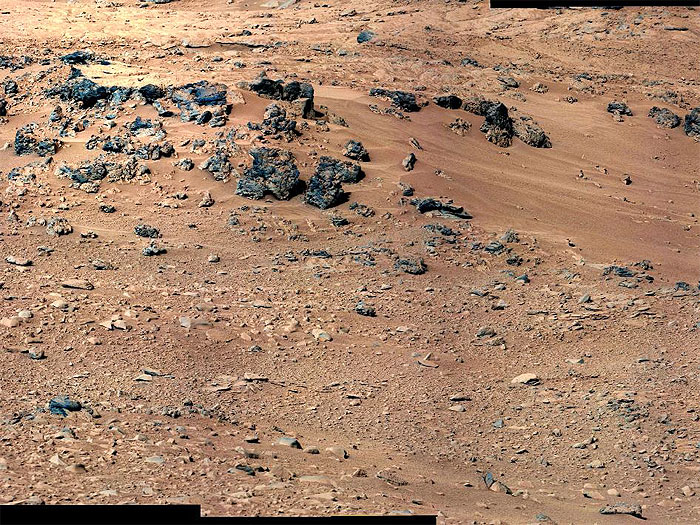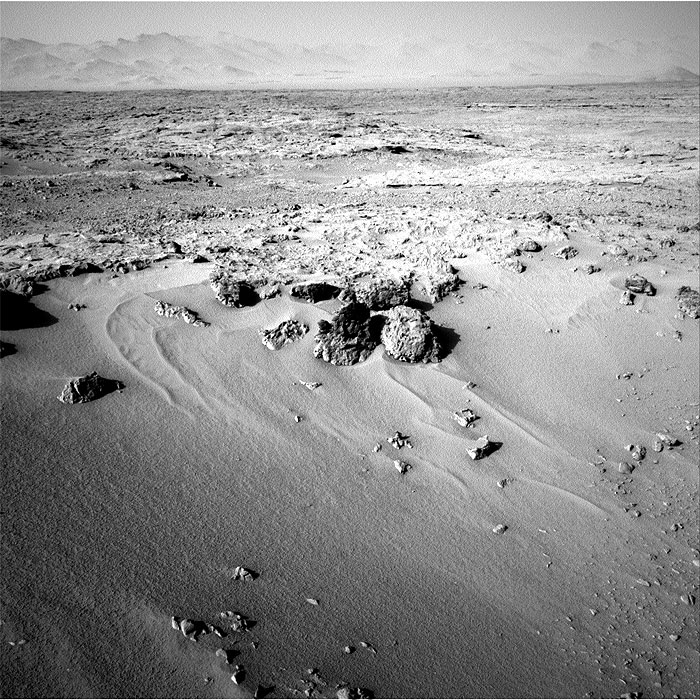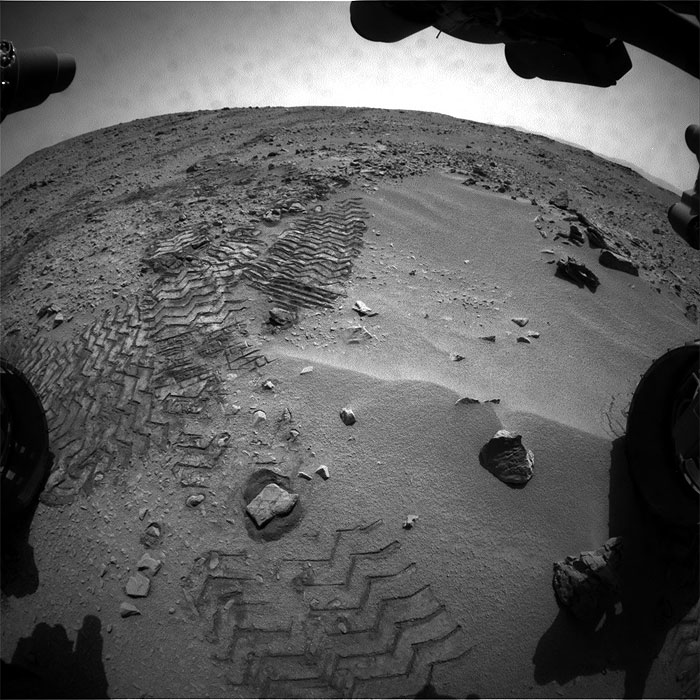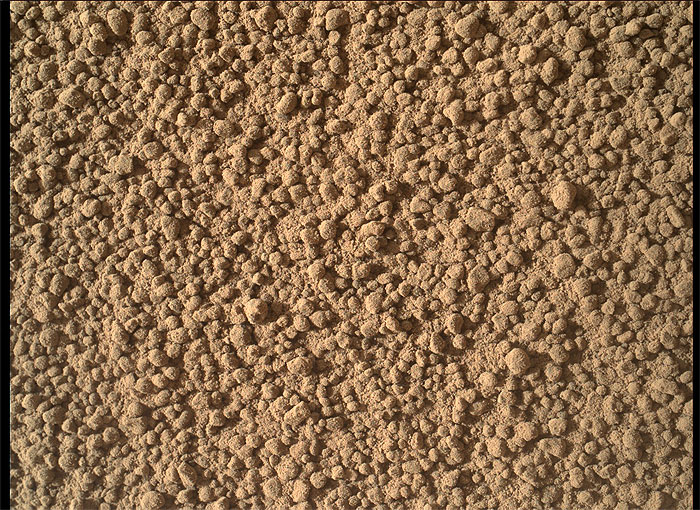-
NASA's Curiosity rover is in a position on Mars where scientists and engineers can begin preparing the rover to take its first scoop of soil for analysis.
Curiosity is the centerpiece of the two-year Mars Science Laboratory mission. The rover's ability to put soil samples into analytical instruments is central to assessing whether its present location on Mars, called Gale Crater, ever offered environmental conditions favorable for microbial life. Mineral analysis can reveal past environmental conditions. Chemical analysis can check for ingredients necessary for life.
"We now have reached an important phase that will get the first solid samples into the analytical instruments in about two weeks," said Mission Manager Michael Watkins of NASA's Jet Propulsion Laboratory in Pasadena, Calif. "Curiosity has been so well-behaved that we have made great progress during the first two months of the mission."
The rover's preparatory operations will involve testing its robotic scooping capabilities to collect and process soil samples. Later, it also will use a hammering drill to collect powdered samples from rocks. To begin preparations for a first scoop, the rover used one of its wheels Wednesday to scuff the soil to expose fresh material.
Next, the rover twice will scoop up some soil, shake it thoroughly inside the sample-processing chambers to scrub the internal surfaces, then discard the sample. Curiosity will scoop and shake a third measure of soil and place it in an observation tray for inspection by cameras mounted on the rover's mast. A portion of the third sample will be delivered to the mineral-identifying chemistry and mineralogy (CheMin) instrument inside the rover. From a fourth scoopful, samples will be delivered to both CheMin and to the sample analysis at Mars (SAM) instrument, which identifies chemical ingredients.
"We're going to take a close look at the particle size distribution in the soil here to be sure it's what we want," said Daniel Limonadi of JPL, lead systems engineer for Curiosity's surface sampling and science system. "We are being very careful with this first time using the scoop on Mars."
The rinse-and-discard cycles serve a quality-assurance purpose similar to a common practice in geochemical laboratory analysis on Earth.
"It is standard to run a split of your sample through first and dump it out, to clean out any residue from a previous sample," said JPL's Joel Hurowitz, a sampling system scientist on the Curiosity team. "We want to be sure the first sample we analyze is unambiguously Martian, so we take these steps to remove any residual material from Earth that might be on the walls of our sample handling system."
Rocknest is the name of the area of soil Curiosity will test and analyze. The rover pulled up to the windblown, sandy and dusty location Oct. 2. The Rocknest patch is about 8 feet by 16 feet (2.5 meters by 5 meters). The area provides plenty of area for scooping several times. Diverse rocks nearby provide targets for investigation with the instruments on Curiosity's mast during the weeks the rover is stationed at Rocknest for this first scooping campaign.
Curiosity's motorized, clamshell-shaped scoop is 1.8 inches (4.5 centimeters) wide, 2.8 inches (7 centimeters) long, and can sample to a depth of about 1.4 inches (3.5 centimeters). It is part of the collection and handling Martian rock analysis (CHIMRA) device on a turret of tools at the end of the rover's arm. CHIMRA also includes a series of chambers and labyrinths for sorting, sieving and portioning samples collected by the scoop or by the arm's percussive drill.
Following the work at Rocknest, the rover team plans to drive Curiosity about 100 yards (about 100 meters) eastward into the Glenelg area and select a rock as the first target for use of its drill.
-

Rocknest' From Sol 52 Location
This patch of windblown sand and dust downhill from a cluster of dark rocks is the "Rocknest" site, which has been selected as the likely location for first use of the scoop on the arm of NASA's Mars rover Curiosity. This view is a mosaic of images taken by the telephoto right-eye camera of the Mast Camera (Mastcam) during the 52nd Martian day, or sol, of the mission (Sept. 28, 2012), four sols before the rover arrived at Rocknest. The Rocknest patch is about 8 feet by 16 feet (1.5 meters by 5 meters).
Scientists white-balanced the color in this view to show the Martian scene as it would appear under the lighting conditions we have on Earth, which helps in analyzing the terrain.
-

Wheel Scuff Mark at 'Rocknest'
NASA's Mars rover Curiosity cut a wheel scuff mark into a wind-formed ripple at the "Rocknest" site to give researchers a better opportunity to examine the particle-size distribution of the material forming the ripple. The rover's right Navigation camera took this image of the scuff mark on the mission's 57th Martian day, or sol (Oct. 3, 2012), the same sol that a wheel created the mark. For scale, the width of the wheel track is about 16 inches (40 centimeters).
-

This image was taken by ChemCam: Remote Micro-Imager (CHEMCAM_RMI) onboard NASA's Mars rover Curiosity on Sol 57 (2012-10-03 15:20:27 UTC) .
-

This image was taken by Navcam: Right A (NAV_RIGHT_A) onboard NASA's Mars rover Curiosity on Sol 57 (2012-10-03 19:07:17 UTC) .
-

This image was taken by Navcam: Right A (NAV_RIGHT_A) onboard NASA's Mars rover Curiosity on Sol 57 (2012-10-03 19:08:54 UTC) .
-

This image was taken by Navcam: Right A (NAV_RIGHT_A) onboard NASA's Mars rover Curiosity on Sol 57 (2012-10-03 19:01:12 UTC) .
-

This image was taken by Navcam: Right A (NAV_RIGHT_A) onboard NASA's Mars rover Curiosity on Sol 57 (2012-10-03 19:02:15 UTC) .
-

This image was taken by Navcam: Left A (NAV_LEFT_A) onboard NASA's Mars rover Curiosity on Sol 57 (2012-10-03 15:51:48 UTC) .
-

This image was taken by Navcam: Left A (NAV_LEFT_A) onboard NASA's Mars rover Curiosity on Sol 57 (2012-10-03 20:01:34 UTC) .
-

This image was taken by Front Hazcam: Right A (FHAZ_RIGHT_A) onboard NASA's Mars rover Curiosity on Sol 57 (2012-10-03 17:13:09 UTC) .
-

This image was taken by Mars Hand Lens Imager (MAHLI) onboard NASA's Mars rover Curiosity on Sol 58 (2012-10-04 18:42:01 UTC) .
-

This image was taken by Mars Hand Lens Imager (MAHLI) onboard NASA's Mars rover Curiosity on Sol 58 (2012-10-04 18:49:54 UTC) .
-

This image was taken by Front Hazcam: Left A (FHAZ_LEFT_A) onboard NASA's Mars rover Curiosity on Sol 58 (2012-10-04 17:09:34 UTC) .
-

This image was taken by Front Hazcam: Left A (FHAZ_LEFT_A) onboard NASA's Mars rover Curiosity on Sol 58 (2012-10-04 18:23:54 UTC) .
-
Fotos: NASA
5887 Views
